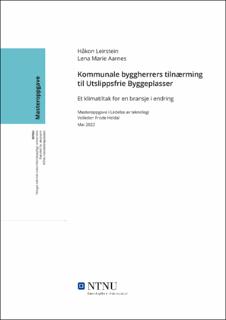| dc.contributor.advisor | Heldal, Frode | |
| dc.contributor.author | Leirstein, Håkon | |
| dc.contributor.author | Aarnes, Lena Marie | |
| dc.date.accessioned | 2022-09-20T17:22:57Z | |
| dc.date.available | 2022-09-20T17:22:57Z | |
| dc.date.issued | 2022 | |
| dc.identifier | no.ntnu:inspera:112633268:114435285 | |
| dc.identifier.uri | https://hdl.handle.net/11250/3019968 | |
| dc.description.abstract | Utslippsfri Byggeplass er et mål kommunale byggherrer har forpliktet seg til gjennom Storbyerklæringen. Målet innebærer at alle aktiviteter på byggeplassen, samt transporten til og fra byggeplassen, skal foregå utslippsfritt i 2025. På nåværende tidspunkt er ikke byggebransjen og det tilhørende teknologimarkedet modent nok til å kunne gjennomføre Utslippsfri Byggeplass i alle byggeprosjekter. Denne oppgaven har derfor som hensikt å undersøke hvilke metoder de kommunale byggherrene benytter, og hvordan de implementer deler av tiltaket i dagens prosjekter, for å utvikle bransjen slik at målet om Utslippsfrie Byggeplasser i 2025 kan bli oppnådd.
I denne oppgaven er det tatt utgangspunkt i fire case-prosjekter i kommunene Bergen, Oslo, Stavanger og Trondheim, som alle er en del av Storbyerklæringen. Studien er gjennomført med et kvalitativt forskningsdesign bestående av dybdeintervjuer og et dokumentstudium. Prosjektledere og anskaffelsesrådgivere fra case-prosjektene ble intervjuet som informanter. Dokumentstudiet besto av anskaffelsesdokumenter og bidro med innsikt i prosjektene.
Ved å studere byggherrenes ulike metoder har oppgaven avdekket usikkerhetene tilknyttet Utslippsfrie Byggeplasser og hvordan byggherrene håndterer disse. Det ble identifisert usikkerhetsmomenter i teknologimarkedet og i organiseringen av prosjektet. For å håndtere usikkerhetene tilegnet byggherrene seg informasjon og kunnskap med hensikt om å opparbeide seg kompetanse til anskaffelsesprosessen. Opparbeidelsen av slik bestillerkompetanse besto blant annet av kommunikasjon med markedet og bransjen, samt intern og ekstern erfaringsoverføring. Videre ble fleksible løsninger kartlagt som et virkemiddel for å håndtere usikkerheter i forbindelse med Utslippsfri Byggeplass.
Oppgaven har også undersøkt hvordan de ulike byggherrene utformer konkurransegrunnlaget. Krav, tildelingskriterier og bonusordninger ble utnyttet slik at både behovet for kontroll i prosjektet og behovet for endring i bransjen ble hensyntatt.
Forskningen i denne oppgaven bidrar til å gi en bedre forståelse av hvordan byggherrene tilrettelegger for Utslippsfri Byggeplass. Tilretteleggingen fremkommer ved å se på sammenhengen mellom usikkerhetshåndteringen i tidligfasen og hvordan Utslippsfri Byggeplass er implementert konkurransegrunnlaget. Utslippsfri Byggeplass er et tiltak som fortsatt er i etableringsfasen og må fokuseres på i større grad hvis målene i Storbyerklæringen skal realiseres. | |
| dc.description.abstract | Emission-Free Construction site (Utslippsfri Byggeplass) is a goal public developers have committed to through the City Declaration (Storbyerklæringen). The goal means that all the activities on the construction site, as well as the transportation into and out of the construction site, shall be completed without any emissions in 2025. The construction industry, as well as the associated market, are currently not developed enough to implement Emission-free Construction sites in all construction projects. As a result, the purpose of this thesis will be to explore the ways public developers implement parts of the measure in current projects, in order to develop the industry so that the goal of Emission-Free Construction sites in 2025 can be achieved.
This thesis is based on four case projects in the municipalities of Bergen, Oslo, Stavanger and Trondheim, all of which are part of the City Declaration. The study used a qualitative research design that included in-depth interviews and a document analysis. Project managers and procurement advisers from the case projects were interviewed as informants. The document analysis included procurement records that provided insight into the projects.
By studying the developers’ various methods, the thesis has revealed the uncertainties associated with Emission-Free Construction sites and how the developers tackle these. Uncertainties have been detected in the technology market, as well as the project’s organization. To deal with the uncertainties, the developers gathered information and knowledge with the goal of becoming knowledgeable about the procurement process. To get this expertise, the developers communicated with the market and industry, as well as transferring experience. Furthermore, flexible solutions were recognized as a tool for dealing with uncertainties associated with Emission-Free Construction site.
The thesis also looked into how the developers design the procurement documents. Both the necessity for project control and the need for change in the industry were taken into account through requirements, award criteria and bonus schemes.
The research in this thesis contributes to providing a better understanding of how developers facilitate Emission-Free Construction sites. The facilitation is a result of the combination of uncertainty management in the early phase and how Emission-Free Construction site is implemented in the procurement documents. Emission-free construction site is a measure that is still in the establishment phase and must be focused on to a greater extent if the goals in the City Declaration are to be realized. | |
| dc.language | nob | |
| dc.publisher | NTNU | |
| dc.title | Kommunale byggherrers tilnærming til Utslippsfrie Byggeplasser | |
| dc.type | Master thesis | |
